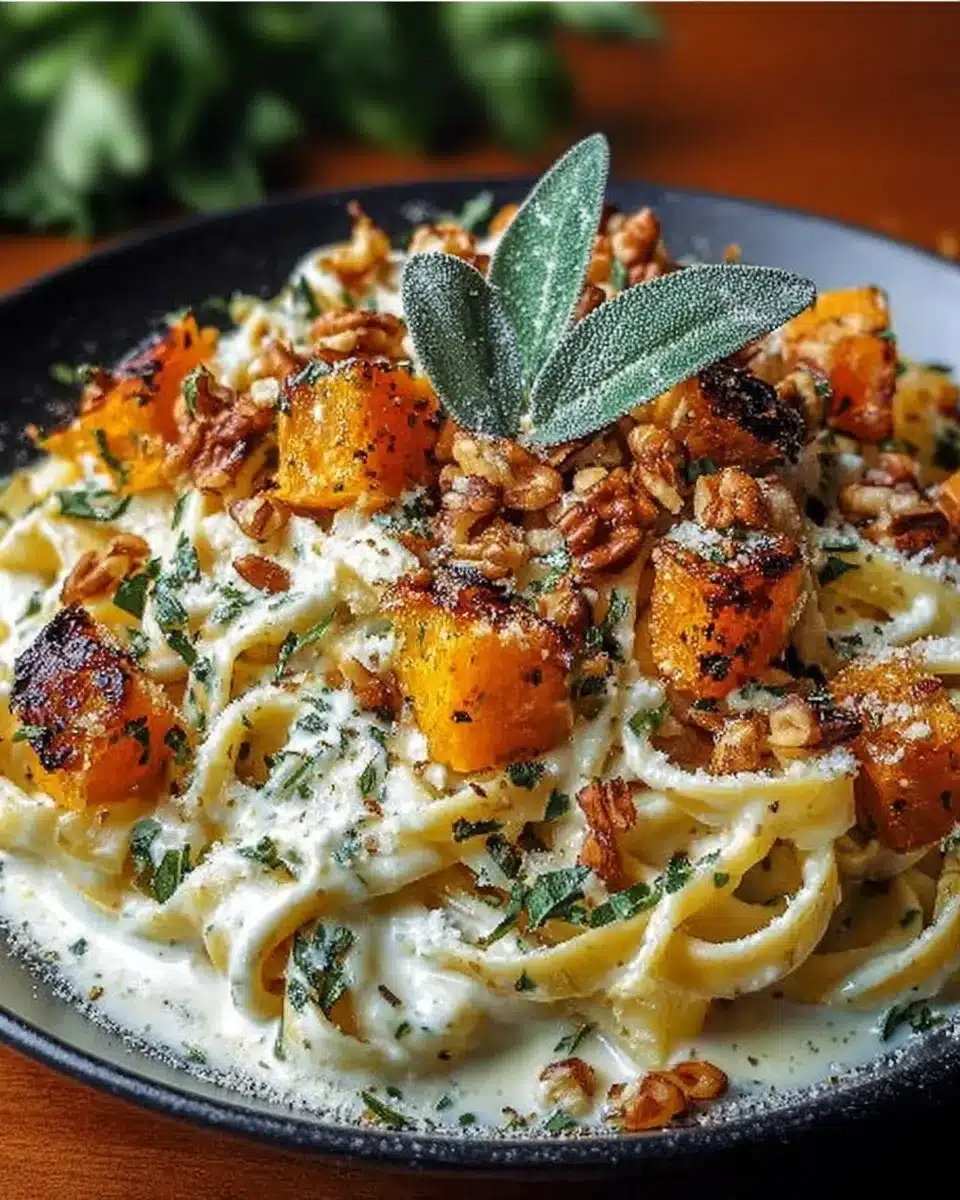Creamy Savory Butternut Squash & Sage Pasta (Cozy Fall Recipe)
Introduction to Savory Butternut Squash & Sage Pasta
You’re stepping into autumn’s warm embrace—that crisp air, falling leaves, that cozy feeling whispering “soup, comfort, and slow-cooked goodness.” Now, picture butternut squash and sage: two classic fall ingredients, each packed with seasonal charm, nutrition, and a flavor punch that says “I’ve arrived.”
This pasta dish? It’s the kind of comforting, nourishing meal that hugs your taste buds and your soul. Sweet‑nutty squash meets pungent sage, silky sauce wraps your pasta—utterly satisfying. And you’re about to make it happen, step by step.
Table of Contents
Understanding the Ingredients in Savory Butternut Squash & Sage Pasta
Butternut Squash: A Seasonal Star
- Flavor & Texture
You get a deep, mellow sweetness and a velvety texture when roasted. It’s both rich and humble—perfect for pasta. - Versatility
This squash can star in soups, salads, or stand behind the scenes as a creamy sauce. Definitely multi‑talented. - Nutritional Benefits
- High in vitamin A (eye‑lovin’ beta‑carotene)
- Good dose of vitamin C (immune support)
- Offers dietary fiber for digestion
- Packs antioxidants that help calm inflammation—autumn fuel for your body.
The Role of Sage
- Culinary Profile & Taste
Sage brings that woody‑earthy, slightly peppery note—like a culinary exhale that elevates the squash’s sweetness. - Health Perks
- Contains anti‑inflammatory compounds
- Has antimicrobial properties
It’s a little herb that packs a wellness punch.
- Flavor Pairing
Squash loves sage. That nutty sweetness is practically begging to be accented by those savory, slightly bitter herb notes.
Step-by-Step Preparation for Savory Butternut Squash & Sage Pasta

Step 1: Preheat the Oven — Set the Stage for Flavor
Start by preheating your oven to 425 °F (220 °C). This high heat is critical—don’t skip it. It helps caramelize the natural sugars in butternut squash, giving you that deep golden-brown color and intensified flavor. Skip this and you’ll end up steaming the squash—not what we want. Caramelization = flavor bomb.
Chef Tip: Always preheat fully before you put in the squash. Cold oven = soggy results.
Step 2: Prep the Butternut Squash — Selection, Peeling & Cutting
Choose a firm squash with a dull, matte skin. Glossy skin usually means it’s underripe.
- Peel with a sharp Y-peeler or chef’s knife (the skin’s thick).
- Cut off both ends, slice it lengthwise, scoop out seeds with a spoon.
- Cube into ½–1 inch pieces. Even sizes roast evenly—don’t go too big or they won’t caramelize properly.
Most People Mess This Up: Uneven chunks. Bigger pieces stay raw while small ones burn. Go for consistency.
Step 3: Season and Roast — Build Depth Early
Toss your squash cubes in a large bowl with:
- 1–2 tablespoons olive oil
- Salt (kosher preferred)
- Freshly ground black pepper
Optional flavor boosters:
- Smoked paprika for a hint of warmth
- Red chili flakes for heat
- A touch of maple syrup (balances sage if going sweet-savory)
Spread on a parchment-lined baking sheet, in a single layer—no overlapping!
- Roast for 25–30 minutes, flipping halfway.
- Look for golden edges and a tender center.
Chef Insight: Don’t overcrowd the pan. That creates steam—not browning. Use two trays if needed.
Step 4: Cook the Pasta — It’s All About Timing
Bring a large pot of water to a boil. Add salt generously—it should taste like the sea. This seasons the pasta from within.
- Use your favorite pasta (penne, rigatoni, or fettuccine all work).
- Cook until al dente—a slight bite in the center. Don’t overcook or it’ll go mushy in the sauce.
- Stir occasionally to prevent sticking.
Why It Matters: Al dente pasta holds its shape and texture when tossed with the rich sauce.
Step 5: Reserve Pasta Water — Liquid Gold for Sauce
Before draining the pasta, scoop out at least 1 cup of the starchy pasta water. This stuff is crucial.
- It helps the sauce stick to the pasta, not slide off.
- It adds a silky texture and helps thin the sauce to your liking.
Pro Move: Add pasta water gradually while tossing the pasta with the sauce—just enough to make everything cling like it’s meant to be.
Building Flavor Layers in Butternut Squash & Sage Pasta
Onion and Garlic in Flavor Development
- Start with diced onion, sauté until translucent. Add garlic near the end (last 30 seconds)—don’t burn it or you’ll get bitterness instead of that sweet garlicky kiss.
Fresh vs. Dried Herbs
- Fresh Sage: verdant, aromatic—add toward the end to keep brightness.
- Dried Sage: potent, more intense—dust in early when onions soften so it rehydrates and blends.
Creating the Sauce for Your Butternut Squash & Sage Pasta
Blending Roasted Squash with Aromatics
- You can go smooth (blender or immersion) for that silky, rich coating—or keep it rustic, chunky and textural. Both hit different comfort zones.
Role of Broth and Cream / Coconut Milk
- Broth (veggie or chicken): adds depth, thins as needed.
- Cream (or full-fat coconut milk for vegan): brings luscious body and richness.
A combo breaststroke: moisture + indulgence, without drowning flavor.
Dietary Alternatives
- Vegan: Coconut milk instead of cream, veggie broth, and use nutritional yeast for a cheesy hint.
- Gluten‑free: Any gluten‑free pasta (buckwheat, corn, rice) works perfectly—check timing.
Adjusting Consistency with Pasta Water
- Add pasta water gradually until sauce clings—not drips. That glue‑like binder = perfect coating and mouthfeel.
Bringing Your Savory Butternut Squash & Sage Pasta Together
Tossing Pasta with Sauce
- Dump pasta into sauce pan, off‑heat if cream-based. The residual heat warms and melds. Toss gently, coating every strand. This is “even coating” territory—no dry patches, no sauce puddles.
Balancing Flavors
- Taste—and tweak. Add a squeeze of lemon juice, or vinegar (a touch of acid) to brightness. Salt to fine‑tune. Pepper (fresh‑cracked) for a little bite. This is where it sings: sweet, savory, bright.
Serving Suggestions for Butternut Squash & Sage Pasta
Presentation Tips
- Use wide bowls or deep plates. You can nestle a tangle of pasta into a “pasta nest,” letting sauce pool around the edges—instantly cozy visuals.
Toppings
- Toasted walnuts or pecans: crunch + nutty contrast.
- Crispy sage leaves: fry for seconds in butter or oil—herby and fragrant shards.
- Grate a little Parmesan or vegan parm if you like.
Pairings
- Light green salad with lemon‑mustard vinaigrette to cut through richness.
- A glass of crisp Sauvignon Blanc or verdant Chardonnay pairs nicely—fresh acidity meets creamy, earthy pasta.
Related Recipes You’ll Love
- Elote pasta salad recipe
- Creamy street corn pasta salad
- Italian pasta salad
- Antipasto pasta salad
- Vegetarian pasta recipes
- Baked feta pasta with vegetables
- High-protein Italian pasta salad
- Tortellini with summer veggies
- Creamy pasta salad
- Classic pasta salad
Key Benefits of Savory Butternut Squash & Sage Pasta
| Benefit | Details |
| Seasonal Ingredients | Uses fall produce at peak flavor and availability—supports seasonal eating. |
| Nutrient-Dense | Rich in vitamins A, C, fiber, and antioxidants from squash and herbs. |
| Comforting Yet Balanced | Creamy texture and cozy flavors without being overly heavy. |
| Customizable & Inclusive | Easily adaptable to vegan, gluten-free, or high-protein versions. |
| Supports Immune Health | Sage and squash both offer anti-inflammatory and immune-boosting properties. |
| Great for Meal Prep | Can be made in advance and reheated without losing texture or taste. |
FAQ: Savory Butternut Squash & Sage Pasta Tips
Q: Can I skip peeling the squash?
Sure, if your squash is young and thin‑skinned—but peeling helps it roast evenly and gives a smoother texture.
Q: Can I make this ahead and reheat?
Yes. Gently add a splash of broth or water when reheating so it stays creamy. Over-reheating thickens it—but a little liquid revives that lusciousness.
Q: What if I don’t have cream or coconut milk?
Use extra broth and a pat of butter—or even full-fat yogurt (heat gently) for tang + body.
Q: Can I use dried pasta vs. fresh?
Absolutely! Fresh cooks faster—watch closely. Either type works fine; cooking time adjustment only.
Conclusion
You just created a bowl of Savory Butternut Squash & Sage Pasta that envelopes your senses in autumnal warmth, nutrition, and cozy flavor. From golden‑caramelized squash to sage‑kissed aromatics, creamy body, and bright finish, this dish highlights the best of fall’s bounty.
Cooking seasonally is both fun and efficient—letting simple ingredients shine. Be creative: swap herbs, change toppings, adapt to your plate and pantry. Most importantly? Enjoy the process—smelling that squash roast, hearing garlic sizzle, tasting sauce thick with flavor, sharing that first twirl. That’s what roots meals in memory.
Now get in there and make it yours. And hey—that’s the pasta I want to eat.
Want more cozy, seasonal recipes like this? [Invite—visit my Pinterest page] and find more dishes that celebrate flavor, technique, and the joy of cooking.
Savory Butternut Squash & Sage Pasta
A cozy autumn pasta dish where roasted butternut squash meets earthy sage, blended into a creamy sauce that hugs every bite of pasta. Comforting, nutritious, and deeply flavorful.
- Prep Time: 20 minutes
- Cook Time: 30 minutes
- Total Time: 50 minutes
- Yield: 4 servings 1x
- Category: Main Course
- Method: Roasting & Stovetop
- Cuisine: American
- Diet: Vegetarian
Ingredients
- 1 medium butternut squash, peeled, seeded, and cubed
- 1–2 tbsp olive oil
- Salt and freshly ground black pepper
- Optional: smoked paprika, red chili flakes, maple syrup
- 1 onion, diced
- 3 cloves garlic, minced
- Fresh sage leaves (or 1 tsp dried sage)
- 1 cup vegetable or chicken broth
- 1/2 cup cream or coconut milk
- 1 lb pasta (penne, rigatoni, or fettuccine)
- Reserved pasta water (about 1 cup)
- Optional toppings: toasted walnuts or pecans, crispy sage leaves, Parmesan or vegan Parmesan
Instructions
- Preheat oven to 425°F (220°C).
- Toss cubed butternut squash with olive oil, salt, pepper, and any optional seasonings. Spread evenly on a parchment-lined baking sheet and roast for 25–30 minutes, flipping halfway, until golden and tender.
- Meanwhile, cook pasta in salted boiling water until al dente. Reserve 1 cup pasta water before draining.
- In a pan, sauté onion in olive oil until translucent. Add garlic and cook for 30 seconds. Stir in sage.
- Blend roasted squash with sautéed aromatics, broth, and cream (or coconut milk) until smooth. Adjust consistency with pasta water.
- Toss cooked pasta with sauce, adding more pasta water as needed until evenly coated.
- Season with salt, pepper, and a squeeze of lemon juice for brightness.
- Serve topped with toasted nuts, crispy sage leaves, and Parmesan or vegan alternative.
Notes
For a vegan option, use coconut milk and nutritional yeast instead of cream and cheese. For gluten-free, substitute with gluten-free pasta.
Nutrition
- Serving Size: 1 plate
- Calories: 480
- Sugar: 6g
- Sodium: 520mg
- Fat: 22g
- Saturated Fat: 9g
- Unsaturated Fat: 12g
- Trans Fat: 0g
- Carbohydrates: 62g
- Fiber: 7g
- Protein: 12g
- Cholesterol: 35mg
Keywords: butternut squash pasta, sage pasta, fall recipes, cozy dinner, creamy pasta


